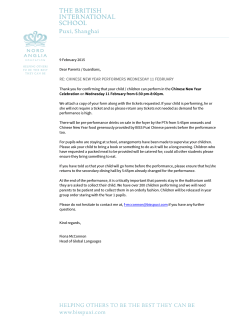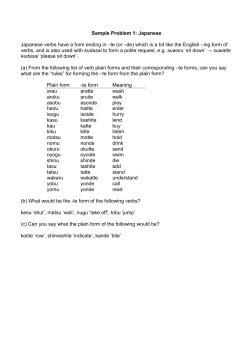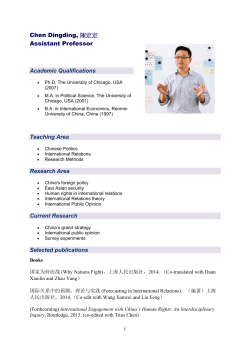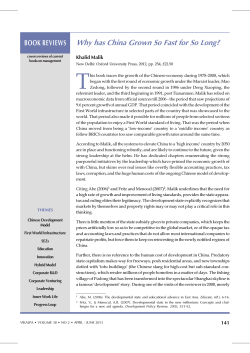
Document 189035
How to learn any language in six months: Chris Lonsdale 如何在 6 个月内学会任何外语:龙飞虎 Have you ever held a question in mind for so long that it becomes part of how you think? 你是否曾经把一个问题留在心中很久, 结果它已经成为你的一种思路? Maybe even part of who you are as a person? 甚至可能已经成为你自己的一部分? Well I’ve had a question in my mind for many, many years and that is: how can you speed up learning? 我思考了一个问题很多很多年,就是:你怎样才能加快自己学习的速度? Now, this is an interesting question because if you speed up learning you can spend less time at school. 那么,这是一个很有趣的问题,因为如果你可以加快自己的学习的速度,你就可以花更少时间在 学校里。 And if you learn really fast, you probably wouldn’t have to go to school at all. 如果你真的可以学习得特别快,你可能根本就不用去上学。 Now, when I was young, school was sort of okay but I found quite often that school got in the way of learning so I had this question in mind: how do you learn faster? 在我小时候,上学还凑合,但我常常发现上学会阻碍学习,因此在心里面我有了这样一个问题: 怎样才能学得更快呢? And this began when I was very, very young. When I was about eleven years old I wrote a letter to researchers in the Soviet Union, asking about hypnopaedia, this is sleep learning, where you get a tape recorder, you put it beside your bed and it turns on in the middle of the night when you’re sleeping, and you’re supposed to be learning from this. (这个想法)在我很小时候已经开始了,大约我 11 岁的时候,我给前苏联的研究者写了一封关于 睡眠学习的信, 所谓“睡觉学习”,就是拿一个磁带录音机放在你床边, 等你入眠后机器开始播 放磁带,(然后)目的是通过这种方式来学习。 A good idea, unfortunately it doesn’t work. 一个好主意,不幸的是它行不通。 But, hypnopaedia did open the doors to research in other areas and we’ve had incredible discoveries about learning that began with that first question. 但睡眠学习确实打开了研究其他领域的大门,并且我们从研究这个问题开始已经有了一些惊人的 发现。 I went on from there to become passionate about psychology and I have been involved in psychology in many ways for the rest of my life up until this point. 从那开始我对心理学充满热情,直到现在我已经投入了几十年的时间从事心理学相关的不同研究 和工作。 In 1981 I took myself to China and I decided that I was going to be native level in Chinese inside two years. 1981 年,我来到了中国,并且我决定在两年内我的汉语要达到像中文母语者一样的水平。 Now, you need to understand that in 1981, everybody thought Chinese was really, really difficult and that a westerner could study for ten years or more and never really get very good at it. 呐,你需要明白的是在 20 世纪 80 年代初,所有人都认为汉语是真的很难学,一个西方人可能学 习 10 年或以上也未必能学好。 And I also went in with a different idea which was: taking all of the conclusions from psychological research up to that point and applying them to the learning process. 还有,我带着一种不同的想法,就是把心理学对这个问题研究所得的全部结论运用到我学习的过 程当中。 What was really cool was that in six months I was fluent in Mandarin Chinese and took a little bit longer to get up to native. 特别棒的是我在六个月内能说流利的中文,不久后,我达到了中文母语者的水平。 But I looked around and I saw all of these people from different countries struggling terribly with Chinese, I saw Chinese people struggling terribly to learn English and other languages, and so my question got refined down to: how can you help a normal adult learn a new language quickly, easily and effectively? 但我看到周围那些来自不同国家的人在为学习中文苦苦挣扎,中国人在为学习英文或其他语言苦 苦挣扎,因此我的问题便细化到:怎样帮助一位正常的成年人更快、更容易和有效地学会第二门 语言。 Now this is a really, really important question in today’s world. 要强调的是,在今天的世界里这是一个非常非常重要的问题。 We have massive challenges with environment. We have massive challenges with social dislocation, with wars, all sorts of things going on and if we can’t communicate we’re really going to have difficulty solving these problems. 我们需要面对大量的(有关)环保问题的挑战,我们需要面对很多社会混乱和战争的挑战,各种 各类事情在发生,如果我们不能沟通那我们将难以解决这些问题。 So we need to be able to speak each other’s languages. This is really, really important. 因此,我们需要能够说对方的语言。这真的非常重要。 The question then is how do you do that? Well, it’s actually really easy. 接下来的问题是,怎样做到?这实际上是很容易的。 You look around for people who can already do it, you look for situations where it’s already working and then you identify the principles and apply them. 看看你周围那些已经做到的人,看看什么情况下它是奏效的,识别这些原则后好好利用它们。 It’s called modeling and I’ve been looking at language learning and modeling language learning for about fifteen to twenty years now. 这是一种高科技模仿,而我已经用这种方法研究语言学习 大约 15 到 20 年了。 And my conclusion, my observation from this is that any adult can learn a second language to fluency inside six months. 接着多年的观察,我得到的结论是, 一个成年人能够在 6 个月内把任何外语学得流利。 Now when I say this, most people think I’m crazy, this is not possible. So let me remind everybody of the history of human progress, it’s all about expanding our limits. 呐,当我说成年人能在 6 个月内学会任何一种外语,大多数人都认为我疯了,这是不可能的。因 此,先让我提醒在座各位关于人类历史的进展,所有人类历史都是在扩展我们的极限。 In 1950 everybody believed that running one mile in four minutes was impossible and then Roger Bannister did it in 1956 and from there it’s got shorter and shorter. 在 20 世纪 50 年代,所有人都相信跑出 4 分钟 1 英里的成绩是不可能的,后来罗杰·班尼斯特在 1965 年做到了,而从那开始跑 1 英里的时间变得越来越短 。 100 years ago everybody believed that heavy stuff doesn’t fly. 100 年前,每个人都相信重的物体不能飞。 Except it does and we all know this. How does heavy stuff fly? 它不但可以飞,而且我们大家都知道这个事实。那么,重物是怎样飞的呢? We reorganize the materials using principles that we have learned from observing nature, birds in this case. 我们观察大自然的原理,在此是鸟飞行的原理,,根据这些我们重新组织材料来使重物可以飞。 And today we’ve gone ever further, so you can fly a car. You can buy one of these for a couple hundred thousand US dollars. 如今,我们甚至走得更远,你可以驾驶一辆会飞的汽车。你可以花几十万美元购买一辆这样的汽 车。 We now have cars in the world that can fly. 我们现在有了会飞的汽车了。 And there’s a different way to fly that we’ve learned from squirrels. 在能飞的松鼠的身上我们学会了另一种不同的方式来飞。 So all you need to do is copy what a flying squirrel does, build a suit called a wing suit and off you go, you can fly like a squirrel. 你只要做的是去复制一只飞鼠如何飞的原理,建造一套翼服,你就可以像一只飞鼠那样可以在天 空中飞翔。 Now, most people, a lot of people, I wouldn’t say everybody but a lot of people think they can’t draw. 那么,大多数人,很多人,我不会说所有人,但很多人认为他们不会画画。 However there are some key principles, five principles that you can apply to learning to draw and you can actually learn to draw in five days. 然而这里有一些重要的原则,5 个原则你可以利用来学习画画并且实际上你可以在 5 天内学会。 So, if you draw like this, you learn these principles for five days and apply them and after five days you can draw something like this. 如果你平时画成这样,那么你学习 5 天这些原则然后应用它们,5 天后,你可以画成这样。 Now I know this is true because that was my first drawing and after five days of applying these principles that was what I was able to do. 我知道这是真的,因为那是我第一次画的,5 天后我应用了这些原则,我可以做到这样。 And I looked at this and I went ‘wow,’ so that’s how I look like when I’m concentrating so intensely that my brain is exploding. 当我看着这个,我“哇”了一声,那就是我非常强烈的,专注到我大脑快要爆炸的样子呀! So, anybody can learn to draw in five days and in the same way, with the same logic, anybody can learn a second language in six months. 因此,任何人都能够用 5 天时间学会画画,同样地,用同样的方式和逻辑,任何人都可以在 6 个 月内学会一门外语。 How: there are five principles and seven actions. 怎么做呢?有 5 个原则和 7 个行动可以跟随。 There may be a few more but these are absolutely core. 可能有更多,但这些绝对是核心部分。 And before I get into those I just want to talk about two myths, dispel two myths. 进入这些点之前我想先说说两个神话并消除它们。 The first is that you need talent. 第一个是你需要有天赋。 Let me tell you about Zoe. 让我跟你们说说关于佐伊的事情。 Zoe came from Australia, went to Holland, was trying to learn Dutch, struggling a great deal and finally people were saying: ‘you’re completely useless,’ ‘you’re not talented,’ ‘give up,’ ‘you’re a waste of time’ and she was very, very depressed. 佐伊是澳大利亚人,她去到荷兰并尝试学习荷兰语。她非常挣扎,最后人们跟她说,“没用的,” “你没有天赋,”“还是放弃吧,”“你根本就是在浪费时间。”她对此感到非常沮丧。 And then she came across these five principles, she moved to Brazil and she applied them and within six months she was fluent in Portuguese, so talent doesn’t matter. 后来,她无意中发现了这 5 个原则,去了巴西,并把这些原则应用到她学习葡萄牙语中,6 个月 内,她可以说流利的葡萄牙语了。因此,天赋不重要。 People also think that immersion in a new country is the way to learn a language. 人们还认为学会一门外语最好的方式就是到说该门语言的国家去。 But look around Hong Kong, look at all the westerners who’ve been here for ten years, who don’t speak a word of Chinese. 但是看看在香港已经呆了 10 年的西方人,还是一句中文也不会说。 Look at all the Chinese living in America, Britain, Australia, Canada who have been there ten, twenty years and they don’t speak any English. 看看那些居住在美国、英国、澳大利亚、加拿大 10 年、20 年的中国人,还是不会一句英文。 Immersion per se doesn’t not work, why? 只呆在一个新的国家本身是没有用的。为什么? Because a drowning man cannot learn to swim. 因为溺水的人是学不会游泳的。 When you don’t speak a language you’re like a baby and if you drop yourself into a context which is all adults talking about stuff over your head, you won’t learn. 当你不能说那种语言,你就像一个婴儿,如果你进入一个环境,那里全部都是成年人在叽叽呱呱 的说一些你完全听不明白的话,你还是学不会。 So, what are the five principles that you need to pay attention to; 那么,你需要注意的那 5 个原则是什么呢? first: there are four words, attention, meaning, relevance and memory, and these interconnect in very important ways. Especially when you’re talking about learning. 首先,有四个词,注意力、含义、关联和记忆,而这些在很多非常重要的方面是相互连接的,特 别在你谈论学习的时候。 Come with me on a journey through a forest. 请跟随我来一趟森林之旅。 You go on a walk through a forest and you see something like this. 你穿越森林,然后你看到一个像这样的东西。 Little marks on a tree, maybe you pay attention, maybe you don’t. 你可能注意到树上的这些小标志,可能没有。 You go another fifty metres and you see this. 然后你继续向前走 50 米,你看到了这个。 You should be paying attention. 你应该要注意了。 Another fifty metres, if you haven’t been paying attention, you see this. 再 50 米,如果你还没注意的话,你会看到这个。 And at this point, you’re paying attention. 当看到这个的时候,你就要注意了。 And you’ve just learned that this is important, it’s relevant because it means this, and anything that is related, any information related to your survival is stuff that you’re going to pay attention to and therefore you’re going to remember it. 你刚刚学习到了这个是重要的,它与你有重要关系,因为它代表这个。任何有关联的东西,任何 有关你生存的信息都是值得你注意的,而你给注意力的就会记住的。 。 If it’s related to your personal goals then you’re going to pay attention to it, if it’s relevant you’re going to remember it. 如果它关于你个人目标的,那么你就会注意到它,如果它与你是有关联的,你就会记住它。 So, the first rule, the first principle for learning a language is focus on language content that is relevant to you. 因此,学习一门语言的第一个原则就是注意那些与你息息相关的语言内容上。 Which brings us to tools. 这就让我们谈到工具。 We master tools by using tools and we learn tools the fastest when they are relevant to us. 我们通过使用工具来掌握工具,而当这些工具与我们息息相关的时候,我们就可以学得很快。 So let me share a story. 先让我分享一个故事。 A keyboard is a tool. 键盘是一个工具。 Typing Chinese a certain way, there are methods for this. That’s a tool. 有不同方法打中文字。这些方法属于工具的一种。 I had a colleague many years ago who went to night school; 多年前,我有一位同事,她上夜校学习中文打字。 Tuesday night, Thursday night, two hours each night, practicing at home, she spent nine months, and she did not learn to type Chinese. 每周二、周四晚上,她都用 2 个小时上课,然后也在家练习,她花了 9 个月的时间,仍然没学会 打中文字。 And one night we had a crisis. 一天晚上,我们有一件紧急的事情。 We had forty eight hours to deliver a training manual in Chinese. 我们有 48 个小时来准备用中文发表一本训练手册。 And she got the job, and I can guarantee you in forty eight hours, she learned to type Chinese because it was relevant, it was important, it was meaningful, she was using a tool to create value. 她获得了这个任务 ,并且我可以像你保证,在 48 个小时内,她学会了用中文打字。因为这是相 关的、重要的、有意义的,她在使用一种工具来创造价值。 So the second tool for learning a language is to use your language as a tool to communicate right from day one. As a kid does. 因此,学习一门语言的第二个工具是从第一天开始,用你的语言作为一种工具来沟通,像一个孩 子那样做。 When I first arrived in China I didn’t speak a word of Chinese, and on my second week I got to take a train ride overnight. 当我初次来到中国,我一句中文都不会说。第二个星期我乘坐火车过夜。 I spent eight hours sitting in the dining car talking to one of the guards on the train。He took an interest in me for some reason, and we just chatted all night in Chinese and he was drawing pictures and making movements with his hands and facial expressions and piece by piece by piece I understood more and more. 我花了 8 个小时,坐在餐车,跟一位乘警聊。因为某种原因,他对我很感兴趣。我们在那用中文 聊了整夜,随着他画画、比划双手并动用他的面部表情,我逐渐地明白越来越多。 But what was really cool, was two weeks later, when people were talking Chinese around me, I was understanding some of this and I hadn’t even made any effort to learn that. 但是真正有趣的是,两个星期后,当人们在我周围说中文的时候,我可以明白一些而且我并没有 为之付出任何努力。 What had happened, I’d absorbed it that night on the train, which brings us to the third principle. 发生了什么?在火车的那晚我已经吸收了中文,也是我们要说的第三个原则。 When you first understand the message, then you will acquire the language unconsciously. 当你已经理解沟通的信息含义,接下来你将不知不觉下意识的获得该语言。 And this is really, really well documented now, it’s something called comprehensible input and there’s twenty or thirty years of research on this. Stephen Krashen, a leader in the field has published all sorts of these different studies and this is just from one of them. 而且这是有充足的证据证明的,我们把它称之为“可明白输入”,而这个概念被研究了了研究二 三十年。此领域的佼佼者史蒂夫·克拉申发布了各类不同的学术研究成果,而这些数据来自他的 一个报告。 The purple bars show the scores on different tests for language. 条形图里面的紫色部分显示不同语言测试的成绩。 The purple people were people who had learned by grammar and formal study, the green ones are the ones who learned by comprehensible input. 紫色代表那些通过正式学习和学习语法的人,绿色的代表那些通过可明白输入学习的人。 So, comprehension works. 因此,可明白意思的输入是有效的。 Comprehension is key and language learning is not about accumulating lots of knowledge. 理解是很关键的,而学语言本身不仅仅是获取大量的知识。 In many, many ways it’s about physiological training. 在很多方面,更多的是生理的训练。 A woman I know from Taiwan did great at English at school, she got A grades all the way through, went through college, A grades, went to the US and found she couldn’t understand what people were saying. 我认识的一位来自台湾的女士,上学时英文成绩很好,大学英语也很优秀。后来,她到了美国, 竟然发现自己听不懂别人在说什么。 And people started asking her: ‘are you deaf?’ and she was. 然后人们开始问她:“你是聋的吗?”她确实是。 English deaf. 英语聋子。 Because we have filters in our brain that filter in the sounds that we are familiar with and they filter out the sounds of languages we’re not. 因为在我们大脑里有一些过滤器会帮助我们过滤熟悉的语言声音进入脑子里,而把不熟悉的语言 声音过滤出去。 And if you can’t hear it, you won’t understand it and if you can’t understand it, you’re not going to learn it. 如果你听不到,你不会明白;你听不明白,你将不能学会它。 So you actually have to be able to hear these sounds. 因此,你必须能够听到这些声音。 And there are ways to do that but it’s physiological training. 这里有一些方法来做到,但这些是生理上的训练。 Speaking takes muscle. 说话需要用到肌肉。 You’ve got forty-‐three muscles in your face, you have to coordinate those in a way that you make sounds that other people will understand. 在你的脸上有 43 块肌肉,你必须协调好这些肌肉来发声,让别人明白你的话。 If you’ve ever done a new sport for a couple of days, then you know how your body feels. And it hurts. 如果你曾经有做过几天新的运动,你会知道你的身体有什么感觉。有点酸疼。 If your face is hurting you’re doing it right. 如果你的面部有这种酸疼的感觉,那就对了。 And the final principle is state. 最后一个原则是状态。 Psycho-‐physiological state. 心理生理的状态。 If you’re sad, angry, worried, upset, you’re not going to learn. 如果你伤心、生气、担心、沮丧,你将不能学会。 Period. 绝对是这样。 If you’re happy, relaxed, in an Alpha brain state, curious, you’re going to learn really quickly, and very specifically you need to be tolerant of ambiguity. 如果你是在一个开心的,放松的,好奇的大脑状态下,你将很快学会,而且,需要明确的一点是,你 需要忍受歧义。 If you’re one of those people who needs to understand 100% every word you’re hearing, you will go nuts, because you’ll be incredibly upset all the time, because you’re not perfect. 如果你是那种在听的时候需要百分百听明白别人在说的每一个词儿 的人之一,你会因为你无时无 刻(的)沮丧感和你的不完美而发疯了。 If you’re comfortable with getting some, not getting some, just paying attention to what you do understand, you’re going to be fine, you’ll be relaxed and you’ll be learning quickly. 如果你对听明白一些、听不明白一些而感到舒服,并把注意力放在你明白的部分,你将会学好, 而且你的状态越轻松,你将学得越快。 So based on those five principles, what are the seven actions that you need to take? 那么在这 5 个原则上,你还需要哪 7 个行动呢? Number one: listen a lot. 第一,多听。 I call it brain soaking. 我把它叫做泡脑子。 You put yourself in a context where you’re hearing tons and tons and tons of a language and it doesn’t matter if you understand it or not. 你把自己置放在听很多很多语言的环境当中,听得明白与否无关重要。 You’re listening to the rhythm ,you’re listening to the patterns that repeat, you’re listening to things that stand out. 在听的时候,你是在听它的节奏、听它重复的模式、听凸出来的词语。 So, just soak your brain in this. 像这个泡泡你的脑子。 The second action: is that you get the meaning first, even before you get the words. 第二个行动是在获取单词之前先获取它的意思。 You go “Well how do I do that?”, 你可能在想,这个我怎么知道的呢? I don’t know the words. Well, you understand what these different postures mean. 我不知道那些单词! 但你可以理解那些不同手势代表的含义。 Human communication is body language in many, many ways, so much body language. 身体语言占领人类交流的一大部分。 From body language you can understand a lot of communication, therefore, you’re understanding, you’re acquiring through comprehensible input. 从身体语言,你可以理解很多对话内容,因此,你通过可明白输入理解、获取它的含义。 And you can also use patterns that you already know. 你还可以利用你已经知道的模式。 If you’re a Chinese speaker of Mandarin and Cantonese and you go Vietnam, you will understand 60% of what they say to you in daily conversation, because Vietnamese is about 30% Mandarin, 30% Cantonese. 如果你是说国语和粤语,当你去到越南,你可以明白 60%的日常用语,因为越南话有 30%的国语 和 30%的粤语。 The third action: start mixing. 第三个行动:开始混合。 You probably have never thought of this but if you’ve got ten verbs, ten nouns and ten adjectives you can say one thousand different things. 你可能之前没有想过这个,但如果你有 10 个动词,10 个名词和 10 个形容词,你可以说一千句不 同的话。 Language is a creative process. 语言是创造的过程。 What do babies do? 孩子是怎么做的呢? Okay: me, bat(h), now, okay, that’s how they communicate. 我,澡澡,现在。。。这就是他们说话的方式。 So start mixing, get creative, have fun with it, it doesn’t have to be perfect it just has to work. 所以现在开始混合、创造并从中获得趣味。你不需要做到完美,你能沟通就好。 And when you’re doing this you focus on the core. 而且当你这样做的时候,你把注意力放在核心上。 What does that mean? 这意味着什么? Well any language has high frequency content. 任何语言都有它的高频内容。 In English 1000 words covers 85% of anything you’re ever going to say in daily communication. 英语有 1000 个高频词覆盖你 85%的日常交流。 3000 words gives you 98% of anything you’re going to say in daily conversation. 而 3000 个高频词将覆盖 98%的日常交流。 You got 3000 words, you’re speaking the language. 你有 3000 个高频词,你将可以说一门外语。 The rest is icing on the cake. 剩余的是锦上添花。 And when you’re just begging with a new language start with the tool box. 当你开始学习一门外语,从工具箱开始。 Week number one in your new language you say things like: ‘how do you say that?’ 第一周,你会用新语言说一些像这样的话“那个你怎么说?” ‘I don’t understand,’ “我不明白,” ‘repeat that please,’ “请重复,” ‘what does that mean,’ “那是什么意思”, all in your target language. 全都用你的目标语言。 You’re using it as a tool, making it useful to you, it’s relevant to learn other things about the language. 你把它当做工具来用,并且利用好它,这对学习该门语言的其他东西是有重大关系的。 It’s by week two that you should be saying things like: ‘me,’ ‘this,’ ‘you,’ ‘that,’ ‘give,’ you know, ‘hot,’ simple pronouns, simple nouns, simple verbs, simple adjectives, communicating like a baby. 第二周,你应该会说一些像“我”、“这个”、“你”、“那个”、“给”、“热”,像个孩子 一样用这些简单的代词、名词、动词、形容词来沟通。 And by the third or fourth week, you’re getting into what I call glue words. 然后第三或第四周,你会进入我称为“胶水词”的这部分。 ‘Although,’ ‘but,’ ‘therefore,’ these are logical transformers that tie bits of a language together, allowing you to make more complex meaning. “虽然”、“但是”、“因此”,这些逻辑工具帮助你把语言的小块紧密地结合在一起,让你制 造更多复杂的意思。 At that point you’re talking. 在那个阶段,你已经进入说话的阶段了! 。 And when you’re doing that, you should get yourself a language parent. 当你这样做的时候,你应该给自己找位语言家长。 If you look at how children and parents interact, you’ll understand what this means. 如果你看看孩子和父母之间的互动,你会明白这个什么意思的。 When a child is speaking, it’ll be using simple words, simple combinations, sometimes quite strange, sometimes very strange pronunciation and other people from outside the family don’t understand it. 当一个孩子说话,它会用简单的词,简单的组合,而有时候会发生奇怪甚至是非常怪的声音,如 果不是家里人根本就不懂它在说什么。 But the parents do. 但是父母却知道。 And so the kid has a safe environment, gets confidence. 因此,孩子有个安全的环境,然后变得有自信。 The parents talk to the children with body language and with simple language which they know the child understands. 父母用孩子可以理解的身体语言和简单句子跟他们说话。 So we have a comprehensible input environment that’s safe, we know it works otherwise none of you would speak your mother tongue. 因此我们有一个很安全的可明白输入的环境。我们知道这个有用,不然的话我们都不会说自己的 母语。 So you get yourself a language parent, who’s somebody interested in you as a person who will communicate with you essentially as an equal, but pay attention to help you understand the message. 因此你可以给自己找个语言家长,他是对你感兴趣的一个人,可以跟你沟通得上的,甚至专注于 帮助你理解的同辈。 There are four rules of a language parent. 语言家长有四个规则。 Spouses by the way are not very good at this, okay? 顺便说一下,配偶在这里没有那么好,明白吗? But the four rules are, first of all, they will work hard to understand what you mean even when you’re way off beat. 那么 4 条规则是,第一,他们会尽可能地理解你的意思,哪怕你脱离节拍。 Secondly, they will never correct your mistakes. 第二,他们从来不会纠正你的错误。 Thirdly they will feed back their understanding of what you are saying so you can respond appropriately and get that feedback and then they will use words that you know. 第三,他们会理解你说的话并给出反馈,好让你适当地回应并获得反馈,并且他们也是说你知道 的单词。 The sixth thing you have to do, is copy the face. 第六件事你需要做的就是模仿面部表情。 You’ve got to get the muscles working right, so you can sound in a way that people will understand you. 你需要把肌肉部位用得准确,别人才可以听明白你发出的声音。 There’s a couple of things you do. 达到此目的,你需要做几件事情。 One is that you hear how it feels, and feel how it sounds which means you have a feedback loop operating in your face, but ideally if you can look at a native speaker and just observe how they use their face, let your unconscious mind absorb the rules, then you’re going to be able to pick it up. 第一,听它是什么感觉的并感觉它是怎样发出声音的,从你的脸上获得反馈。如果条件理想的话, 你可以看着母语者并观察他们的面部,让你下意识地吸收这些规则,然后你将能够获取到它。 And if you can’t get a native speaker to look at, you can use stuff like this: [slides]. 如果你没有母语者可以看着学习的话,你可以用像这样的东西。 And the final idea here, the final action you need to take is something that I call “direct connect.” 最后一个行动是你需要“直接联系”。 What does this mean? 什么意思呢? Well most people learning a second language sort of take the mother tongue words and take the target words and go over them again and again in their mind to try and remember them. 大多数人学习外语几乎都是用母语的单词对照目标语言,反复地在心中念并尝试记住它们。 Really inefficient. 这样做效率真的很低。 What you need to do is realize that everything you know is an image inside your mind, it’s feelings, 你需要做的是意识到你所知道的事情在你的脑海里都有一个画面和感觉。 if you talk about fire you can smell the smoke you can hear the crackling, you can see the flames, 如果你说到“火”,你可以闻到那个烟味,你可以听到那燃烧的爆裂声,你可以看到那火焰, so what you do, is you go into that imagery and all of that memory and you come out with another pathway. 所以你需要做的是进入那些意象和有关的所有的记忆力,然后从另一条通道出来。 So I call it ‘same box, different path.’ 我把这叫做“殊途同归”(同一个盒子,不同的路)。 You come out of that pathway, you build it over time you become more and more skilled at just connecting the new sounds to those images that you already have, into that internal representation. 你从那条通道出来,你将建立这种技能并且越来越熟练地把新的声音连接到你心里已经知道的画 面去。 And over time you even become naturally good at that process, that becomes unconscious. 往后你甚至很擅长走这个过程,甚至是无意识的。 So, there are five principles that you need to work with, seven actions, if you do any of them, you’re going to improve. 因此,你需要运用的那 5 个原则和 7 个行动,如果你运用其中任何一个,都将得到进步。 And remember these are things under your control as the learner. 并且记住,作为学习者,这些事情都在你的掌控之下。 Do them all and you’re going to be fluent in a second language in six months. 如果你做到以上全部,你将会在六个月内学会流利的外语。 Thank you. 谢谢。
© Copyright 2025





















